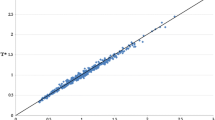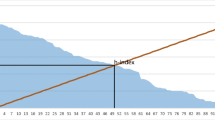Abstract
A common problem in comparative bibliometric studies at the meso and micro level is the differentiation and specialisation of research profiles of the objects of analysis at lower levels of aggregation. Already the institutional level requires the application of more sophisticated techniques than customary in evaluation of national research performance. In this study institutional profile clusters are used to examine which level of the hierarchical subject-classification should preferably be used to build subject-normalised citation indicators. It is shown that a set of properly normalised indicators can serve as a basis of comparative assessment within and even among different clusters, provided that their profiles still overlap and such comparison is thus meaningful. On the basis of 24 selected European universities, a new version of relational charts is presented for the comparative assessment of citation impact.
Similar content being viewed by others
References
Adams, J., K. Gurney, L. Jackson (2008). Calibrating the zoom - a test of Zitt’s hypothesis, Scientometrics, 75(1): 81–95.
Braun, T., W. Glänzel, A. Schubert (1985), Scientometric Indicators. A 32-Country Comparison of Publication Productivity and Citation Impact. World Scientific, Singapore - Philadelphia.
Braun, T., W. Glänzel (1990), United Germany: The new scientific superpower? Scientometrics, 19(5–6): 513–521.
Duda, R. O., P. E. Hart (1973), Pattern Classification and Scene Analysis. New York: Wiley.
Glänzel, W., A. Telcs, A. Schubert (1984), Characterization by truncated moments and its application to Pearson-type distributions. Zeitschrift für Wahrscheinlichkeitstheorie und Verwandte Gebiete, 66: 173–183. (Correction: Probability Theory and Related Fields, 74 (1987) 317.)
Glänzel, W., A. Schubert (1988), Characteristic scores and scales in assessing citation impact. Journal of Information Science, 14: 123–127.
Glänzel, W., A. Schubert (1992), Some facts and figures on highly cited papers in the sciences, 1981–1985, Scientometrics, 25(3): 373–380.
Glänzel, W. (1997), On the reliability of predictions based on stochastic citation processes, Scientometrics, 40(3): 481–492.
Glänzel, W. (2000), Science in Scandinavia: A bibliometric approach, Scientometrics, 48(2): 121–150. (Correction: Scientometrics, 49 (2) (2000) 357)
Glänzel, W., A. schubert (2003), A new classification scheme of science fields and subfields designed for scientometric evaluation purposes, Scientometrics, 56(3): 357–367.
Glänzel, W. (2007), Characteristic scores and scales. A bibliometric analysis of subject characteristics based on long-term citation observation, Journal of Informetrics, 1(1): 92–102.
Glänzel, W. (2008), On some new bibliometric applications of statistics related to the h-index, Scientometrics, 76(3) forthcoming
Leta, J., W. Glänzel, B. Thijs (2006), Science in Brazil. Part 2: Sectoral and institutional research profiles, Scientometrics, 67(1): 87–105.
Moed, H. F., R. E. De Bruin, Th. N. Van Leeuwen (1995), New bibliometric tools for the assessment of national research performance: database description, overview of indicators and first applications, Scientometrics, 33(3): 381–422.
Moed, H. F. (1996), Differences in the construction of SCI based bibliometric indicators among various producers: A first over view, Scientometrics, 35(2): 177–191
Price, D. J. De Solla (1976), A general theory of bibliometric and other cumulative advantage processes, Journal of the American Society for Information Science, 27(5–6): 292–306.
REIST-2 (1997), The European Report on Science and Technology Indicators 1997. EUR 17639. European Commission, Brussels.
Schubert, A., W. Glänzel (1983), Statistical reliability of comparisons based on the citation impact of scientific publications, Scientometrics, 5(1): 59–74.
Schubert, A., T. Braun (1986), Relative indicators and relational charts for comparative-assessment of publication output and citation impact, Scientometrics, 9(5–6): 281–291.
Schubert, A., W. Glänzel, T. Braun (1989), Scientometric datafiles. A comprehensive set of indicators on 2649 journals and 96 countries in all major fields and subfields 1981–1985. Scientometrics, 16(1–6): 3–478.
Schubert, A., W. Glänzel (2007), A systematic analysis of Hirsch-type indices for journals, Journal of Informetrics, 1(3): 179–184.
Tague, J. M. (1981), The success-breeds-success phenomenon and bibliometric processes, Journal of the American Society for Information Science, 32(4): 280–286.
Thijs, B., W. Glänzel (2008), A structural analysis of publication profiles for the classification of European research institutes, Scientometrics, 74(2): 223–236.
Thijs, B., W. Glänzel (2009), A structural analysis of benchmarks on different bibliometric indicators for European research institutes based on their research profile, Scientometrics, forthcoming.
Van Raan, A. F. J. (2006a) Statistical properties of bibliometric indicators: Research group indicator distributions and correlations, Journal of the American Society for Information Science and Technology, 57(3): 408–430.
VVan Raan, A. F. J. (2006b), Comparison of the Hirsch-index with standard bibliometric indicators and with peer judgment for 147 chemistry research groups, Scientometrics, 67(3): 491–502.
Vinkler. P. (1986), Evaluation of some methods for the relative assessment of scientific publications, Scientometrics, 10(3–4): 157–177.
Zitt, M., S. Ramanana-Rahary, E. Bassecoulard (2005), Relativity of citation performance and excellence measures: From cross-field to cross-scale effects of field-normalisation, Scientometrics, 63(2): 373–401.
Author information
Authors and Affiliations
Corresponding author
Rights and permissions
About this article
Cite this article
Glänzel, W., Thijs, B., Schubert, A. et al. Subfield-specific normalized relative indicators and a new generation of relational charts: Methodological foundations illustrated on the assessment of institutional research performance. Scientometrics 78, 165–188 (2009). https://doi.org/10.1007/s11192-008-2109-5
Received:
Published:
Issue Date:
DOI: https://doi.org/10.1007/s11192-008-2109-5




